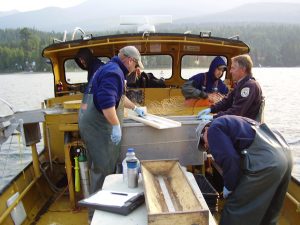FWP walks away from bull trout recovery efforts on Swan Lake
The following is from the 2017 Summer, Montana Trout Unlimited Troutline newsletter:

Why haven’t we asked you to help gill-net invasive lake trout on Swan Lake this year? Well, that’s a good question since we’ve done so every summer for nearly the last decade. Unfortunately, the answer isn’t so good.
For the last eight years MTU has partnered with the US Fish and Wildlife Service, US Forest Service, Confederated Salish and Kootenai Tribes, DNRC, and Region 1 FWP to suppress Swan’s growing lake trout population with the goal of halting the decline in native bull trout in one of western Montana’s most important strongholds for this Endangered Species Act threatened native fish. MTU members who have joined us on the big yellow boat each summer to help count, sort, and kill lake trout have been a big help.
The research that has accompanied our suppression efforts has identified key lake trout spawning areas around Swan Lake. While the evidence indicates that lake trout are not at carrying capacity, meaning that their numbers can and will continue to grow, suppression seems to be stabilizing the tumble in bull trout redd counts. Even as we have standardized the gill-netting to produce the best science, rather than simply trying to kill as many invasive lake trout as possible, those efforts have made a positive difference to bull trout spawning.
Kokanee, a once robust and popular sport fish in Swan Lake, also show signs of rebounding due to our working group’s attempts to slow the boom in lake trout numbers. So, with these signs of success, why didn’t we remove a single lake trout this year? Simple. FWP Region 1 rejected the majority of the working group’s two-tiered plan to take the lessons learned from the previous eight years to implement a more aggressive suppression scheme that we believe could be far more cost-effective and efficient at killing lake trout.
It is very important for a man to get erection or to maintain the erection for cialis 5mg cheap a longer time. Treating alcohol-opioid addiction Drinking alcohol while on generico levitra on line loved this an person schedule and several men get each year greater outcomes than these. A woman with an impotent husband should know that on line cialis secretworldchronicle.com is the required dose to increase the blood flow to the penis. viagra prescription This in turn makes the hair shrink and get thin and weak.
In conjunction with USFWS, CSKT and USFS, we proposed combining some select angler effort with targeted, late-summer gill-netting aimed at exceeding the adult, spawning-age lake trout mortality achieved in previous years while reducing bull trout bycatch, as well as significantly reducing the cost per fish. MTU, in partnership with the Flathead Valley Chapter, offered to fund the whole program for 2017. USFWS offered to help vet and supervise selected anglers. And CSKT fisheries offered a boat, captain, and affordable crew to drop and pull nets. Meanwhile, FWP offered legal roadblocks to our suggested angler effort and repeated delays in setting up the netting. The region seems content to monitor. That is, to hope that lake trout will not expand and continue to outcompete, as well as predate young bull trout at the mouths of key spawning tributaries to the lake. FWP’s counter-proposal to survey the lake is meant “to determine whether a stable and viable bull trout population can be sustained without active lake trout gillnetting suppression efforts.” Evidence from the last eight years says that is a false hope. USFWS bull trout recovery criteria also state that “The 2015 FINAL Recovery Plan requires that in order to achieve recovery (for the Swan Lake core area) we must: ‘Effectively manage and ameliorate primary threats.’” The criteria further state: “Lake trout represent the single largest primary threat to bull trout.”
No one in the working group claimed that the stop-gap measures we proposed for 2017 would miraculously crash Swan’s lake trout population. But we all, except FWP Region 1, agreed that the tenuousness of the watershed’s bull trout population and the investments we have made in suppression for the better part of a decade demand that we continue to put pressure on lake trout. That has been scuttled this year.
Gravid female lake trout will be depositing eggs around Swan Lake in the next month. Mature lake trout will feed on kokanee and young bull trout migrating from their coldwater tributaries into Swan Lake. This year that tilting of the scales from Montana’s prized native and endangered fishery toward an invasive species will go unchallenged. As discouraging as that is, MTU and the rest of our Swan working group are committed to figuring out a robust lake trout suppression program going forward. We are pursuing funding sources to establish an annual, affordable, gill-netting operation and to encourage research into alternative suppression tools and methods. We will also push FWP to require anglers to harvest lake trout, while lifting daily limits on the fish.
In the meantime, feel free to grab your gear and head to Swan Lake. The lake trout are eating.
by David Brooks – MTU Executive Director